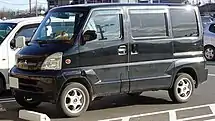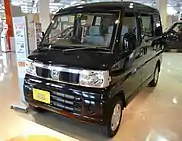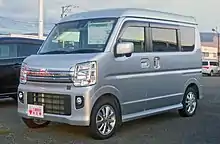| Mitsubishi Town Box | |
|---|---|
 First generation Mitsubishi Town Box (Early model) | |
| Overview | |
| Manufacturer | Mitsubishi Motors (1999–2011) Suzuki (2014–present) |
| Also called | Nissan Clipper Rio Suzuki Every Wagon (2014–present) Proton Juara (Town Box Wide) |
| Production | First generation: April 1999–November 2011 (Town Box) June 1999–August 2001 (Town Box Wide) June 2007–January 2012 (Clipper Rio) Rebadged Suzuki Every Wagon: February 2014–present |
| Assembly | Mizushima plant, Kurashiki, Okayama, Japan |
| Body and chassis | |
| Class | Microvan (Town Box) Minivan (Town Box Wide) |
| Body style | 5-door van |
| Layout | Front-engine, rear-wheel-drive Front-engine, front-wheel-drive |
| Related | Mitsubishi Minicab CMC Veryca |
| Powertrain | |
| Engine | |
| Transmission | 4-speed automatic 5-speed manual |
| Dimensions | |
| Wheelbase | 2,390 mm (94.1 in) |
| Length | Town Box: 3,395 mm (133.7 in) Town Box Wide: 3,605 mm (141.9 in) |
| Width | Town Box: 1,475 mm (58.1 in) Town Box Wide: 1,535 mm (60.4 in) |
| Height | Town Box: 1,890 mm (74.4 in) Town Box Wide: 1,810 mm (71.3 in) |
| Curb weight | Town Box: 970–1,030 kg (2,138–2,271 lb) Town Box Wide: 990–1,050 kg (2,183–2,315 lb) |
| Chronology | |
| Predecessor | Mitsubishi Minicab Bravo |
The Mitsubishi Town Box is a kei car (Town Box) and minivan (Town Box Wide) produced for the Japanese domestic market (JDM) by the Japanese automaker Mitsubishi Motors. It was initially available with the alloy-headed 4A30 657 cc inline-four engine, but switched to the 3G83 659 cc straight-three engine in 2002. In August 2001, a slightly larger version of the same vehicle powered by a 4A31 1.1 L straight-four, the Mitsubishi Town Box Wide, was discontinued. The first generation Town Box was discontinued in November 2011, ending the twelve-year production run. The model returned in February 2014 as a rebadged version of the Suzuki Every Wagon.
The first generation Town Box was also sold in Japan as the Nissan Clipper Rio,[1] while the Town Box Wide was also produced under licence in Malaysia as the Proton Juara.[2]
Suzuki OEM deal
In February 2014, Mitsubishi started selling rebadged Suzuki Carry trucks and Every vans as the Mitsubishi Minicab. The passenger-oriented Every Wagon, which has a more designed rear end but shares the Carry Van's chassis code, was also included and received the Town Box badge (DS64W). As the Every only had a year of production left, Mitsubishi did not spend a lot of effort to distinguish their model, restraining themselves to changing the badges. In March 2015 a new Every Wagon and Town Box was introduced (DS17W). The newest model offers increased interior space, a longer wheelbase, and the new Suzuki R06A engine; turbocharged and intercooled. It is offered in G and G Special specs.
Annual production and sales
| Year | Production | Domestic sales | Export sales |
|---|---|---|---|
| 1998 | 2,261 | n/a | |
| 1999 | 14,421 3,616 (Wide) |
n/a | n/a |
| 2000 | 8,953 1,441 (Wide) |
8,772 809 (Wide) |
– 664 (Wide) |
| 2001 | 6,662 2,939 (Wide) |
7,357 79 (Wide) |
420 2,640 (Wide) |
| 2002 | 4,949 | 5,170 | – |
| 2003 | 5,561 | 5,430 | – |
| 2004 | 4,262 | 4,201 | – |
| 2005 | 4,143 | 4,171 | – |
| 2006 | 3,357 | 3,649 | – |
| 2007 | 10,105 | 3,696 | – |
| 2008 | 8,241 | 3,162 | – |
(Sources: Facts & Figures 2000, Facts & Figures 2005, Facts & Figures 2009, Mitsubishi Motors website)
Gallery
 1999 Mitsubishi Town Box rear view
1999 Mitsubishi Town Box rear view Mitsubishi Town Box Wide
Mitsubishi Town Box Wide 2007 Nissan Clipper Rio
2007 Nissan Clipper Rio_right.JPG.webp) Second generation Mitsubishi Town Box G (DS64W)
Second generation Mitsubishi Town Box G (DS64W) Third generation Mitsubishi Town Box G 4WD (DS17W)
Third generation Mitsubishi Town Box G 4WD (DS17W) Third generation Mitsubishi Town Box G 4WD (DS17W)
Third generation Mitsubishi Town Box G 4WD (DS17W)
References
- ↑ Nunn, Peter (June 19, 2007). "Oh, Kei Go! Nissan's New Clipper Rio Debuts". Winding Road. Archived from the original on November 9, 2007.
- ↑ "Proton Moves into a New Niche", Chips, Autoword.com.my, July 23, 2001
External links
- Mitsubishi Town Box, Mitsubishi-motors.com
- "Mitsubishi Town Box" (in Japanese). Mitsubishi-motors.co.jp. July 1, 2007. Archived from the original on June 23, 2007.